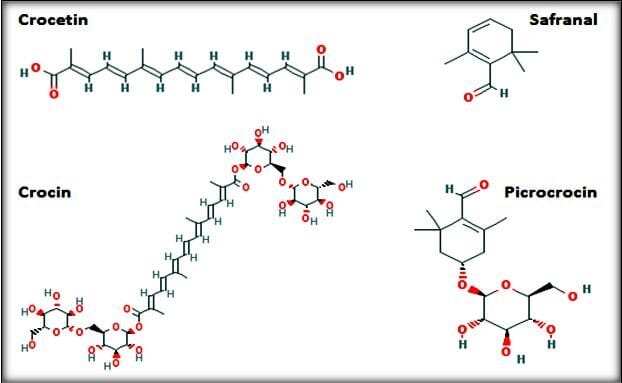
There are many factors influencing saffron production yield and quality before the flowering stage including the number of irrigations (3_5 times), amount of rainfall, the minimum and maximum temperature in summer and winter, respectively, applying fertilizer, etc.
Introduction
Saffron quality is also strongly dependent on postharvest parameters as well as crop management in the field. There are several crucial steps in saffron processing, from picking the flowers in farms to drying of stigmas, that are characterized by local traditional practices. Quality characteristics of saffron are directly affected by the postharvest processing stages. Microbial counts and color strength along with apparent features of the stigmas determine the price of each batch and are significantly process-dependent.
The flowering stage of saffron varies from 15 to 25 days and the number of flowers reaches a maximum around 7_10 days after the appearance of the first flower. The best time for collecting flowers is before sunrise when they are in budding mode, as no sunlight exposure has occurred and the tepals protect stigmas from physical damage during transport to the processing stage. With the dawn of the sun, flowers are surrounded with light and temperatures rise, resulting in opening of the buds. This not only reduces the physical strength of the tepals but also the quality of the stigma, especially its color strength. Extended exposure to light and high temperatures causes flowers to be withered and spoiled. The stigmas are polluted with pollen from stamens. More importantly stigmas may stick to the stamens, causing the separation process to fail, which downgrades market acceptance.
International classification of saffron stigmas
Saffron stigmas are classified based on the physicochemical characteristics including color strength, appearance, style length, and diameter. Table below summarizes the specifications of the International Standardization Organization (ISO) 3632 for the physicochemical classifications of saffron in filaments, cut filaments, and powder forms. The ISO 3632 is the guide for international transactions and has been adopted by national standardization organizations in the European Union (e.g., AFNOR, EΛOT).
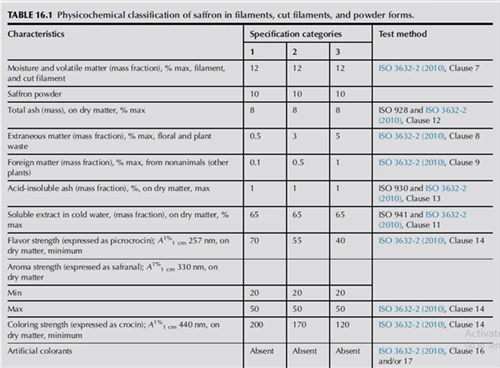
As shown in Fig. A, a stigma consists of a red section containing all three bioactive components of saffron and a white section called the style. The style length, attachment to the stigma, as well as the morphological features of the red section have crucial roles in saffron categorization. For example, in Iran the expression “strong stigma” refers to the ones that are thicker in diameter as well as straight and smooth in length. If a stigma is instead a thin and wavy structure, the stigma is called a “weak stigma” (Fig. B).
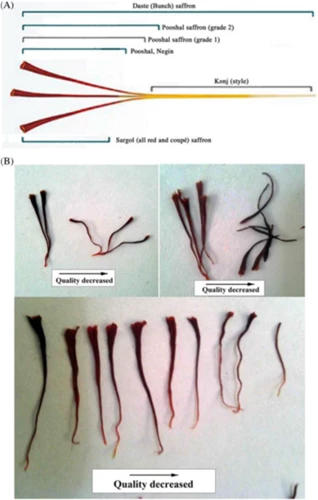
Iranian trade categories
Iran, as the biggest producer of saffron, has set national specifications for characterization of saffron in addition to the international specifications. Based on Iranian standards, the different types of traded saffron are Sargol, Pooshal, and Daste as detailed below:
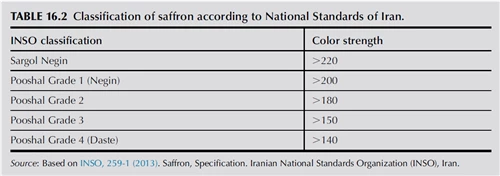
Saffron drying methods
Similar to the other agricultural crops, postharvest processing plays a crucial role in the quality characteristics of saffron and its physicochemical as well as microbiological properties. The drying process is aimed at protecting the crocins by stopping the enzymatic reactions responsible for its biodegradation, which is achieved with temperatures above 60_C for the minimum possible time. Selecting the most appropriate drying method is one of the important steps in postharvest processing in order to prepare saffron stigmas with the highest amount of crocins, while obtaining the best morphological features. Generally, during the drying process the moisture content of stigmas decreases between 8% and 10%. The methods of saffron drying are traditional (sun drying, dark-air drying, toasting) and modern (such as freeze drying, microwave drying, etc.) and are selected and applied based on available equipment.
The main difference in the methods is related to the temperature applied in the process. Table below summarizes different studies on the drying of saffron and application of various drying techniques.
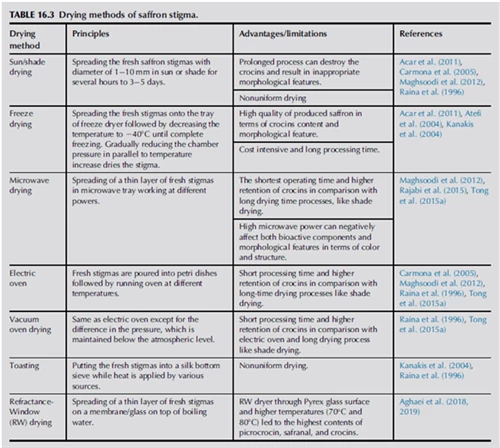
Extraction of saffron bioactive components
Scientists in the phytochemical field have tracked a variety of components in saffron stigmas. The researchers revealed that three groups of compounds responsible for color, taste, and aroma are present in dried stigma.These are crocins, picrocrocin, and safranal, respectively. The red color of stigmas is due to the presence of uncommon hydrophilic carotenoids named crocins, which are glycosyl and gentiobiosyl esters of crocetin, the 8,80-diapocarotene-8,80 dioic acid, not naturally found free/unesterified.
The difference in the type of sugar moieties placed in the positions R1 and R2 results in the six classes of crocins including crocin 1, crocin 2, crocin 20, crocin 3, crocin 4, and crocin 5. In this regard, glycosyl and gentiobiosyl moieties along with _H are indwelled in R1 and R2 at different patterns, making various types of crocins. Regarding isomeric structure of crocins occurring in saffron, both isomeric structures of cis and trans are present in saffron. Total crocins are measured by reading absorbance of saffron extract with a standard concentration using a UV-vis spectrophotometer at wavelength of 440 nm.
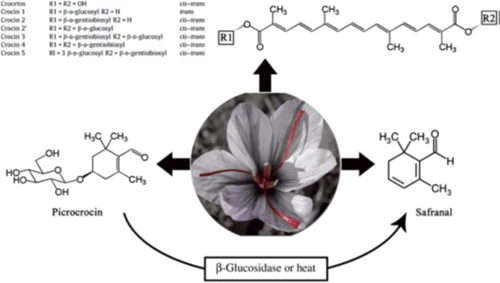
The bitter taste of saffron comes from a monoterpene glucoside named picrocrocin (C16H26O7, 4-(b-Dglucopyranosyloxy) 22,6,6-trimethyl-1-cyclohexene-l-carboxaldehyde). This component not only brings a charming bitter taste but also acts as a precursor for safranal (2,6,6-trimethyl-1,3-cyclohexadiene-1-carboxaldehyde), an essential oil responsible for the saffron aroma. Safranal makes up 70% of the total volatile constituents of saffron. It has been reported that this carboxaldehyde volatile component is present in saffron due to the heat applied during the drying process and also because of enzymatic activity of ß-glucosidase on picrocrocin. Researchers have proposed another pathway in which picrocrocin, due to loss of glucose molecule, is converted into oxysafranal (HTCC, 2,6,6-trimethyl-4-hydroxy-1-carboxaldehyde-1-cyclohexene), an intermediate volatile precursor of safranal. HTCC is also converted into safranal through release of a molecule of water.
Several techniques have been developed in order to extract saffron bioactive components with the highest quality while obtaining the highest extraction efficiency. Up to now, a variety of methods including high hydrostatic pressure extraction, solid-phase microextraction (SPME), supercritical fluid extraction (SFE), maceration, microwave-assisted extraction, subcritical water extraction (SWE), ultrasonic solvent extraction, thermal desorption (TD), hydrodistillation (HD), microsimultaneous hydrodistillation_extraction (MSDE), and vacuum headspace have been carried out in order to obtain whole saffron extract or with the aim of purification and separation of a specified saffron bioactive component. Due to the presence of compounds of both hydrophilic and lipophilic nature in saffron, selecting the appropriate solvent as well as other process variables such as extraction time and temperature are crucial determinants of the saffron extract quality and quantity.